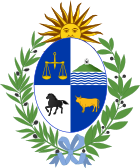 |
|---|
General elections were held in Uruguay on 27 November 1966, alongside a constitutional referendum. [1] The result was a victory for the Colorado Party, which won the most seats in the Chamber of Deputies and received the most votes in the presidential election.

